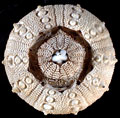The Echinoid Directory
Ctenocidaris Mortensen, 1910, p. 3
[See also Ctenocidaris (Eurocidaris) Mortensen, 1909]
| Diagnostic Features |
|
|---|---|
| Distribution | Recent, Antarctica; possibly Danian, western Europe. |
| Name gender | feminine |
| Type | Ctenocidaris speciosa Mortensen, 1910, p. 4, by original designation. |
| Classification and/or Status |
|
| Remarks |
|





